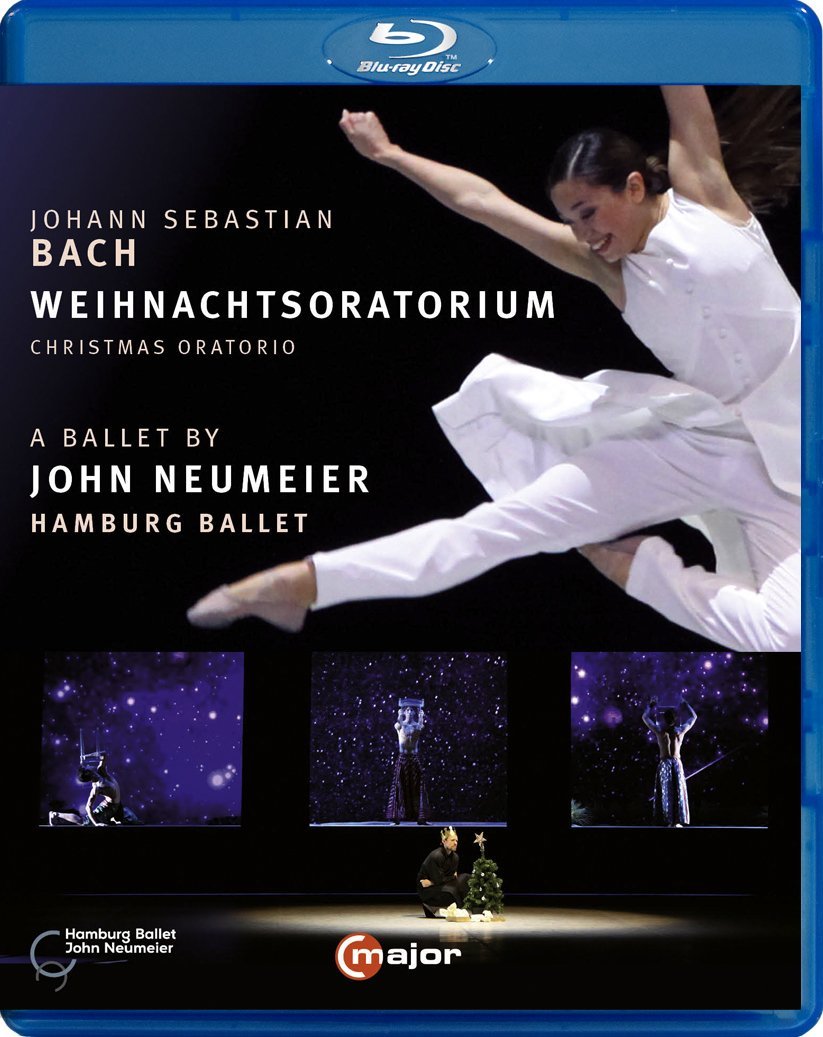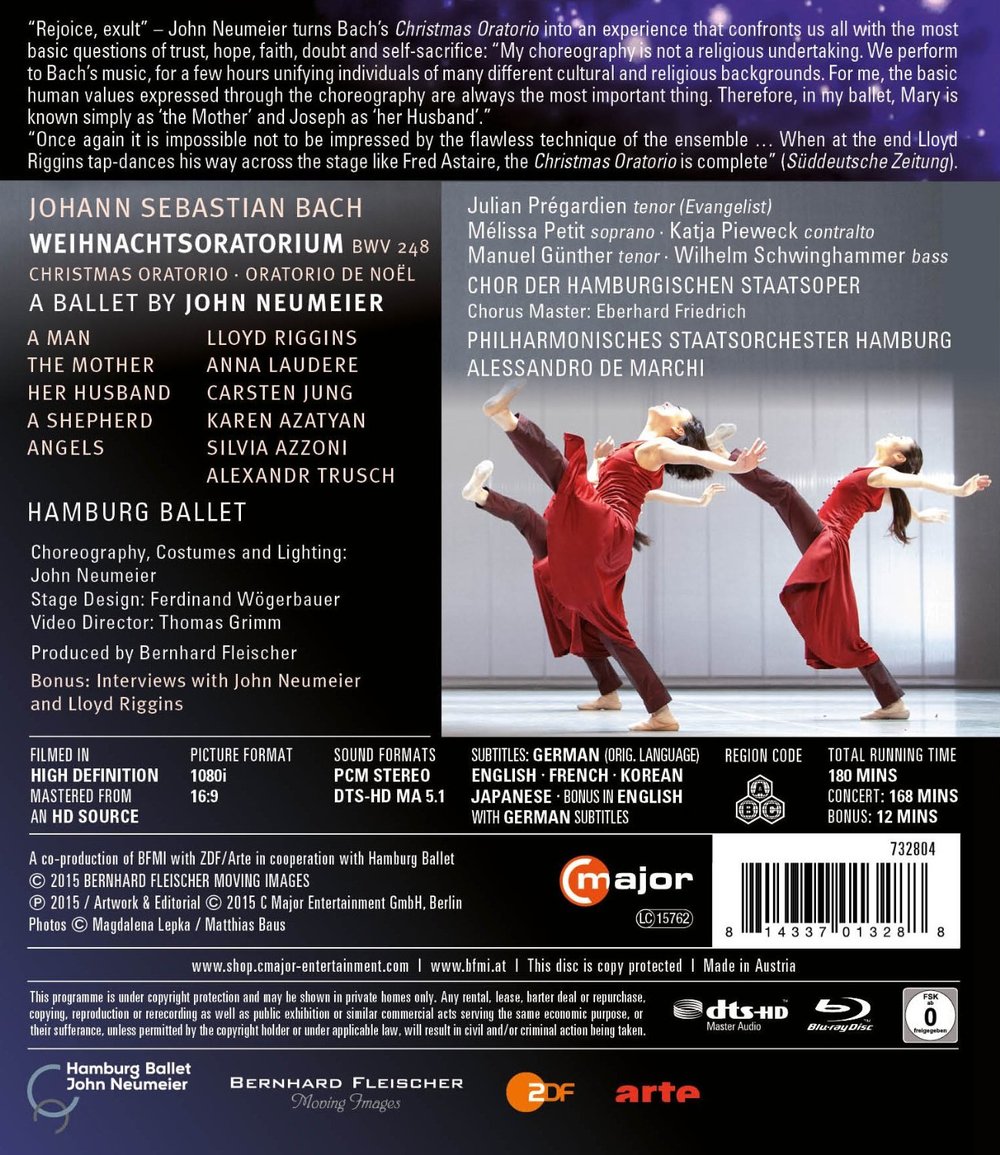

Christmas Oratorio Ballet. Music is the Bach Christmas Oratorio (BWV 248) to a sacred text. Directed and choreographed by John Neumeier. Performed 2014 by the Hamburg Ballet at the Hamburg State Opera. Dancing stars are Lloyd Riggins (A man), Anna Laudere (The mother), Carsten Jung (Her husband), Karen Azatyan (A shepherd), Silvia Azzoni (Angel), Alexandr Trusch (Angel), Yuka Oishi and Silvano Ballone (Solo pair), Leslie Heylmann and Christopher Evans (Solo pair), and Vladimir Kocić (Street sweeper). Ensemble dancers: Lucia Ríos, Mayo Arii, Kristína Borbélyová, Yaiza Coll, Winnie Dias, Natalie Ogonek, Zhaoqian Peng, Madoka Sugai, Priscilla Tselikova, Miljana Vračarić, Marcelino Libao, Aleix Martínez, Konstantin Tselikov, Emanuel Amuchástegui, Jacopo Bellussi, Graeme Fuhrman, Alijoscha Lenz, Dale Rhodes, Lizhong Wang, and Eliot Worrell. Alessandro De Marchi conducts the Hamburg State Philharmonic Orchestra and the Chorus of the Hamburg State Opera (Chorus Master Eberhard Friedrich). Singing stars are Julian Prégardien (tenor), Mélissa Petit (soprano), Katia Pieweck (contralto), Manuel Günther (tenor), and Wilhelm Schwinghammer (bass). Costumes and lighting by John Neumeier; stage design by Ferdinand Wögerbauer; video direction by Thomas Grimm; produced by Bernhard Fleischer. Sung in German. Released 2015, disc has 5.1 dts-HD Master Audio sound output. Grade: A+
This is the most complex and formidable modern ballet title to come out in HDVD (in 2016). There is a lot involved in this 2 and 1/2 hours of dancing! First, there are 6 Bach cantatas performed in a row with an orchestra, chorus, and 5 opera singers. (If you had been a member of Bach's church, you would probably have gone to church 6 times to hear 1 cantata on each the 6 Days of Christmas.)
Then there is the libretto with parts of the New Testament plus original rhyming poetry in German. The Christ story is grounded in the prehistoric hero legends of the ancient Greeks. These legends had the following elements: (1) a god visits a woman, (2) an inevitable humble birth, (3) a perilous childhood, (4) a precocious education, (5) an adulthood full of heroic/miraculous achievements, (6) an untimely death, and (7) an apotheosis. Christ wanted reform the Jewish religion and, I think, make it easier for gentiles to convert. It wasn't too hard to stop the man, but his ideas flourished. After several centuries the Christian religion emerged as an amalgamation of the hero legend and Jewish moral principles. Now on top of this 6,000 years of religion in the West, Neumeier adds another layer: he backs off from Mary and Joseph and presents the story of "the mother" and "her husband" in a parable for persons of all religions and degrees of atheism! Now to screenshots!
A man (Lloyd Riggins), who appears to be homeless, tries to celebrate Christmas with his little plastic tree and a candle. At first the man is mostly an observer, but gradually he will become a full participant in the dancing. His job is to encourage the protagonists and make comments (mute, of course) on the events portrayed. He's the same character as Hans Christian Anderson in The Little Mermaid ballet. Maybe he's really Neumeier, but probably he's "Everyman."
The mother (Anna Laudere) and her husband (Carsten Jung) are travelling dusty roads to the husband's home town. The road is full of other travellers. They have to register in a census and pay a tax. Or maybe they are all fleeing a civil war. The trip is torturous for the mother, who is full-term pregnant:
There's a never-ending battle between "purist" ballet fans (who want every frame of a ballet video to show the whole stage) and the "romantic" fans (who want to see something like a movie, even if many of the shots don't show the whole bodies of all the dancers). In a bonus extra, Neumeier states that he doesn't want subject film to be a "documentary" of what takes place on the stage. Neumeier wants his ballet video to tell a story forcefully in the home theater. He gives videographer Thomas Grimm all the light and access Grimm needs to get a wide variety of shots from various angles and ranging from full-stage to extreme close-ups. The screenshots in this review tend to be dark, but the entire ballet looks great in my home theater. Next below we see a close-up of the mother's weary desperation as she wonders, "When and where will I deliver?"
Neumeier keeps the action going at an almost frantic pace. But he's also a master at coming up with tableaux you've never seen before, such as this image with the subtitles, "and they laid [the new-born son] in a manger." It's astonishing to see how many combinations and formations Neumeier achieves with only 31 dancers (lots of costume changes):
The poor husband grieves over his inability to protect his wife from hardship:
Angels appear to the mother with the message, "today the Savior is born to you." In Neumeier's overlay, the hope that every mother has for her child makes that child a kind of savior:
These angels look and act a bit different from the ones you see on Christmas cards. Here the female angel announces the birth to a shepherd who was watching his flock nearby:
Coming up with a modern-day image of Christ (at any age) is a hopeless task. The baby is represented by a folded cloth (actually a shirt). The mother is in anguish over how she will care for the child while on the move. She tells the baby, "Sleep, my darling."
The shepherd, who is inured to hardship, tries to comfort and encourage the mother. In the shot below, he is wearing the shirt that the mother unfolded:
The exhausted mother prays to her son, "Henceforth look after the well-being of all."
The host from heaven praises God and prays for "Peace on Earth":
All those who had seen the miracles spread the word:
And soon the mother and husband find themselves, even in their poverty and desperation, the center of so much attention! People come to worship the baby. The husband is beside himself in perplexity, but the mother, mulling over all she has heard, believes:
When it comes time to leave, the mother says to those who also believed in the Savior, "I will diligently remember you all."
"Full of joy, time without end."
"There in the other life." I devote 3 streenshots to this short segment of the film because I think they illustrate something I've heard several times: Words can say a lot. So can music. But dance expresses things that neither words nor music reach. Now the mother's feeling when she leaves the shepherds are deeply expressed (by Mary) in the words of the Bible. Bach can't add much to that. But Neumeier gets the mother's feeling across with a force I've never felt before from this story:
8 days have passed and it is time for the circumcision and naming of the boy. Now the mother has new doubts. Should she use the name the angels called him? Or could that be a provocation that might one day cause trouble for her son?
She and her husband each ask, "How can I worthily name my son."
The angels appear again singing "Jesus. All the world exalts you. . . ."
And the mother is encouraged again:
But there are still more visitors: wise men (not credited) from the East who can read the signs of the heavens:
The dangerous King Herod (not credited) heard of the wise men and interviewed them. He asked them to report back to him when they found the baby:
But the angels appear to the wise men and warn them not to trust Herod. They return to their homes by another road:
I hope these few screenshots give you some idea of the majesty of this ballet. Every move has its mysterious meaning for you to excavate.
The music was performed in a large hall with a fair size orchestra and chorus which is only rarely and briefly shown. The soloists can, however, be seen from time to time nearby on the side of the stage. The music is fine in support of the dancing, and SQ is adequate. But if you are interested in the music as much as the dancing, I suggest you try the HDVD Bach Christmas Oratorio with Philippe Herreweghe conducting the Collegium Vocale Gent. The Herreweghe title has an especially nice original instrument ensemble with excellent singers. The video is superb, and you get splendid views of all the singers accompanied by precise subtitles. I find this much superior to listening to the Hamburg Opera performers with the video off.
Neumeier was born and educated in America. As a young dancer he went to Europe for experience. At age 31 he became director of the Hamburg Ballet and has stayed there for more than 40 years. He has about 100 ballets credits including many long narrative pieces. We have 2 other Neumeier HDVDs, both wonderful: the A+ La Dame aux camélias and his A+ The Little Mermaid. In a bonus extra to subject title filmed late in 2014, Neumeier defends all the coming-and-going-with-suitcases in his ballet as a reference to those homeless and seeking refuge all over the world. I think that was before Germany admitted 1,000,000 more refugees from Syria. I wonder if the Chancellor of Germany saw this ballet in 2014. Neumeier is more than a dancer, artist, and choreographer — he's also a prophet!
OR























